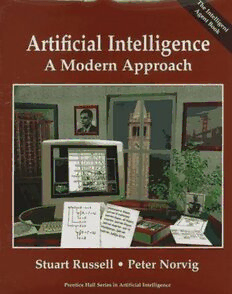
Artificial Intelligence: A Modern Approach PDF
947 Pages·1995·35.618 MB·English
Most books are stored in the elastic cloud where traffic is expensive. For this reason, we have a limit on daily download.
Preview Artificial Intelligence: A Modern Approach
Description:
This is an introduction to the theory and practice of artificial intelligence. It uses an intelligent agent as the unifying theme throughout, and covers areas that are sometimes underemphasized elsewhere. These include reasoning under uncertainty, learning, natural language, vision and robotics. The book also explains in detail some of the more recent ideas in the field, including simulated annealing, memory-bounded search, global ontologies, dynamic belief networks, neural nets, inductive logic programming, computational learning theory, and reinforcement learning.Review:As some reviewers have said, this is probably the most comprehensive AI textbook on the market. The "pros" of the book have been covered pretty well by other reviewers, so I'll limit my review to some of the things that bug me about the book.1. No answer key for any problems. This feature has been standard in textbooks for decades as a way for students to self-check their understanding of the material. 2. Examples are scant and sometimes stop in the middle. For example, in Chapter 13, the example of applying Bayes' Rule gives one approach and indicates that it will discuss an alternative approach, but then the text just goes off on another path and never completes the example.3. Inconsistent and (sometimes) convoluted pseudocode for the algorithms. Pseudocode should be a fairly-close-to-English approximation of the algorithm, but this book seems to mix RTL, English, and any other notation. Though the appendix includes an attempt at explaining their rationale behind their own brand of pseudocode, it's incomplete at best. Also, the function names don't follow any convention I've ever seen (I have 30+ years experience in software), and aren't even consistent within the book.4. Condescending language. This should never occur in a textbook. In far too many places, the authors tell us that "the sharp-eyed reader will have noticed" or similar phrases, which basically implies, "if you didn't get our explanation and find the hidden subtext, you are not sharp-eyed". All such language should have been edited out.The authors came so close to writing a classic, but sadly missed the mark. I think that any professors who claim that their students "universally love this book" are deluding themselves. Still, if your professor is good at explicating the material, it's worth going through it once, then switching to other materials, maybe primary source materials in the subfield(s) that grab your interest.
See more
The list of books you might like
Most books are stored in the elastic cloud where traffic is expensive. For this reason, we have a limit on daily download.
